初三英语集体备课教案
九年级英语集体备课教案 U10-3
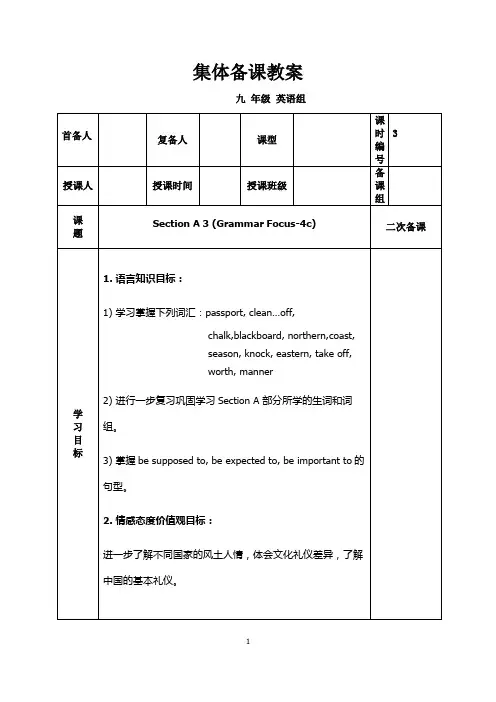
--我应当7点钟到。
--When were you ________ _______ _________?
--I _______ ________ ______ _______ at 7:00.
4) --我应该穿牛仔裤吗?
--不应该穿,希望你穿西服打领带。
--__________ I ________ _________ wear jeans?
3.It be +adj.+to do sth.
Itbe important to do sth. ….做某事很重要。
e.g. It is important to learnEnglishwell.学好英语很重要。
IV. Consolidation
Work on4a.
1.让学生读句子,学习新词,了解句意,选择合适的短语填空。
e.g. Is it worth all the trouble?
The new car cost a lot of money, but it’s certainly worth it.
The book is well worth reading.
【运用】根据汉语意思完成英语句子,每空一词。
那个地方值得参观。
4.杰克被要求每天早上练习英语。
Jack _____________________ English every morning.
Answers:are supposed to read / should read
aren’t supposed to put / shouldn’t put
was supposed to post
2)进行一步复习巩固学习Section A部分所学的生词和词组。
九年级英语备课教案大全5篇
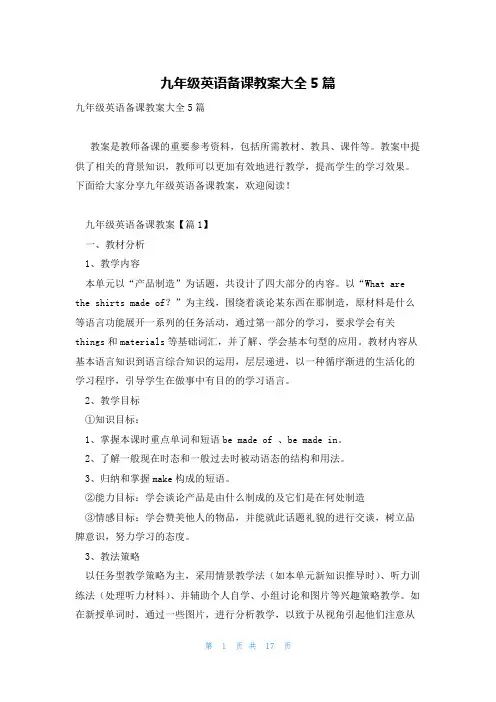
九年级英语备课教案大全5篇九年级英语备课教案大全5篇教案是教师备课的重要参考资料,包括所需教材、教具、课件等。
教案中提供了相关的背景知识,教师可以更加有效地进行教学,提高学生的学习效果。
下面给大家分享九年级英语备课教案,欢迎阅读!九年级英语备课教案【篇1】一、教材分析1、教学内容本单元以“产品制造”为话题,共设计了四大部分的内容。
以“What are the shirts made of?”为主线,围绕着谈论某东西在那制造,原材料是什么等语言功能展开一系列的任务活动,通过第一部分的学习,要求学会有关things和materials等基础词汇,并了解、学会基本句型的应用。
教材内容从基本语言知识到语言综合知识的运用,层层递进,以一种循序渐进的生活化的学习程序,引导学生在做事中有目的的学习语言。
2、教学目标①知识目标:1、掌握本课时重点单词和短语be made of 、be made in。
2、了解一般现在时态和一般过去时被动语态的结构和用法。
3、归纳和掌握make构成的短语。
②能力目标:学会谈论产品是由什么制成的及它们是在何处制造③情感目标:学会赞美他人的物品,并能就此话题礼貌的进行交谈,树立品牌意识,努力学习的态度。
3、教法策略以任务型教学策略为主,采用情景教学法(如本单元新知识推导时)、听力训练法(处理听力材料)、并辅助个人自学、小组讨论和图片等兴趣策略教学。
如在新授单词时,通过一些图片,进行分析教学,以致于从视角引起他们注意从而记住单词。
采取任务型教学策略的目的是主要是让学生多练多用,在做中学、学中乐、乐中掌握。
4、学习策略采用合作式学习方式,有目的的让学生预习,在完成任务的活动中主动的学习语言,养成继续学习英语和学好英语的良好习惯。
强调学生不仅要在课上积极发言、多练,并鼓励他们课后积极进行英语学习、积极参加训练。
二、重难点分析重点词汇通过图片和对话解决。
如:chopsticks,coin,blouse,silver,ilk,be made of等。
人教版九年级下册英语Unit 8集体备课教案
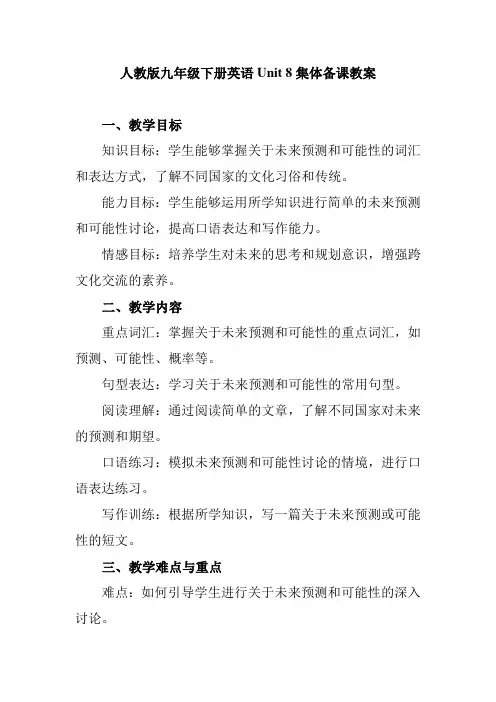
人教版九年级下册英语Unit 8集体备课教案一、教学目标知识目标:学生能够掌握关于未来预测和可能性的词汇和表达方式,了解不同国家的文化习俗和传统。
能力目标:学生能够运用所学知识进行简单的未来预测和可能性讨论,提高口语表达和写作能力。
情感目标:培养学生对未来的思考和规划意识,增强跨文化交流的素养。
二、教学内容重点词汇:掌握关于未来预测和可能性的重点词汇,如预测、可能性、概率等。
句型表达:学习关于未来预测和可能性的常用句型。
阅读理解:通过阅读简单的文章,了解不同国家对未来的预测和期望。
口语练习:模拟未来预测和可能性讨论的情境,进行口语表达练习。
写作训练:根据所学知识,写一篇关于未来预测或可能性的短文。
三、教学难点与重点难点:如何引导学生进行关于未来预测和可能性的深入讨论。
重点:掌握关于未来预测和可能性的词汇和表达方式,了解不同国家的文化习俗和传统。
四、教具和多媒体资源黑板:用于书写重点词汇和句型。
投影仪:播放关于未来的视频资料,增强学生对未来的感性认识。
教学软件:用于进行互动练习和测试。
五、教学方法激活学生的前知:通过提问学生未来的规划和梦想,激活学生的相关背景知识。
教学策略:采用讲解、示范、小组讨论、案例分析等多种教学方法,引导学生积极参与课堂活动。
学生活动:组织学生进行关于未来预测和可能性的讨论,提高学生的思维能力和表达能力。
六、教学过程导入(5分钟)通过投影仪展示一些关于未来的图片或视频,吸引学生的注意力。
随后提问学生未来的规划和梦想,引导学生进入本单元的主题。
讲授新课(30分钟)(1)介绍本单元的重点词汇和句型,通过例句和情境模拟帮助学生理解并运用。
(2)阅读理解:让学生阅读一篇关于未来的文章,并提出问题让学生回答,检验学生的理解程度。
(3)口语练习:组织学生进行关于未来预测和可能性的小组讨论,并进行口头表达。
教师给予指导和反馈。
(4)写作训练:让学生写一篇关于未来预测或可能性的短文,要求运用所学知识,注意语法和拼写错误。
九年级英语集体备课教案
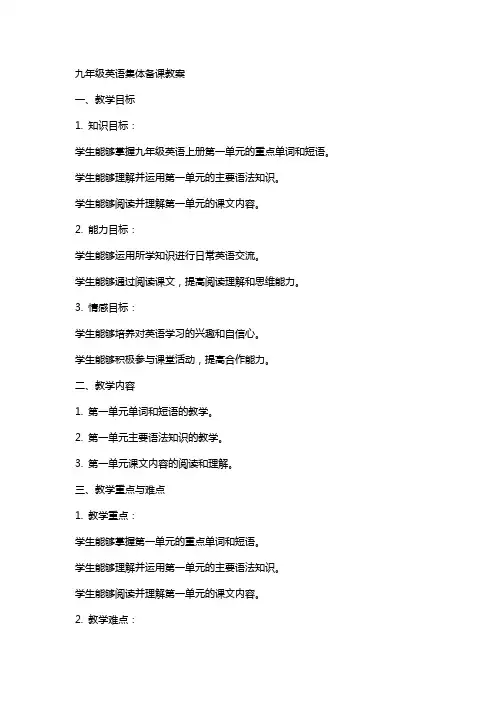
九年级英语集体备课教案一、教学目标1. 知识目标:学生能够掌握九年级英语上册第一单元的重点单词和短语。
学生能够理解并运用第一单元的主要语法知识。
学生能够阅读并理解第一单元的课文内容。
2. 能力目标:学生能够运用所学知识进行日常英语交流。
学生能够通过阅读课文,提高阅读理解和思维能力。
3. 情感目标:学生能够培养对英语学习的兴趣和自信心。
学生能够积极参与课堂活动,提高合作能力。
二、教学内容1. 第一单元单词和短语的教学。
2. 第一单元主要语法知识的教学。
3. 第一单元课文内容的阅读和理解。
三、教学重点与难点1. 教学重点:学生能够掌握第一单元的重点单词和短语。
学生能够理解并运用第一单元的主要语法知识。
学生能够阅读并理解第一单元的课文内容。
2. 教学难点:学生对第一单元语法知识的理解和运用。
学生对课文内容的理解和分析。
四、教学方法1. 任务驱动法:通过设置各种任务,激发学生的学习兴趣和动力。
2. 情境教学法:通过创设真实的语言环境,提高学生的语言运用能力。
3. 合作学习法:通过小组合作,培养学生的团队合作能力和沟通能力。
五、教学步骤1. 单词和短语的教学:教师通过PPT展示第一单元的单词和短语。
学生跟读并模仿单词和短语的发音。
教师通过例句解释单词和短语的意思。
学生进行单词和短语的练习。
2. 语法知识的教学:教师通过PPT讲解第一单元的主要语法知识。
学生跟随教师的学习步骤,理解和掌握语法知识。
教师通过例句和练习题,帮助学生巩固语法知识。
3. 课文内容的阅读和理解:教师分配课文阅读任务给每个学生。
学生阅读课文,理解课文内容。
教师组织学生进行课文内容的讨论和分析。
学生进行课文阅读的练习和测试。
六、教学评价1. 课堂参与度:观察学生在课堂上的参与情况,包括发言、讨论、合作等,评价学生的积极性。
2. 单词和短语掌握情况:通过听写、默写等方式检查学生对单词和短语的掌握程度。
3. 语法知识运用:通过语法练习题,评估学生对语法知识的运用能力。
初三英语集体备课教案
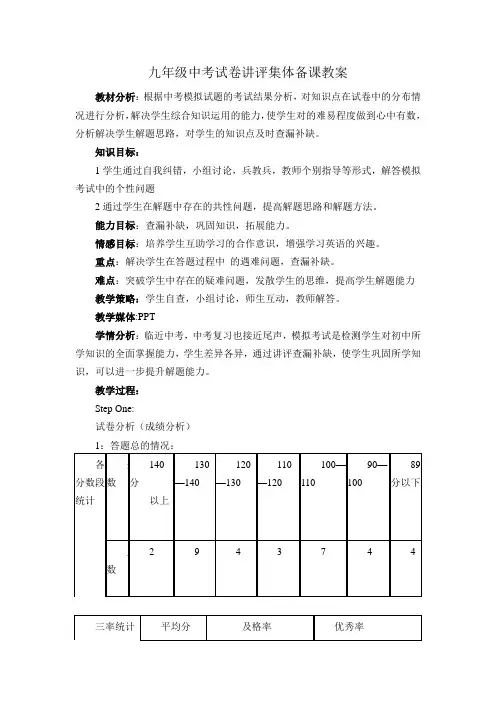
九年级中考试卷讲评集体备课教案教材分析:根据中考模拟试题的考试结果分析,对知识点在试卷中的分布情况进行分析,解决学生综合知识运用的能力,使学生对的难易程度做到心中有数,分析解决学生解题思路,对学生的知识点及时查漏补缺。
知识目标:1学生通过自我纠错,小组讨论,兵教兵,教师个别指导等形式,解答模拟考试中的个性问题2通过学生在解题中存在的共性问题,提高解题思路和解题方法。
能力目标:查漏补缺,巩固知识,拓展能力。
情感目标:培养学生互助学习的合作意识,增强学习英语的兴趣。
重点:解决学生在答题过程中的遇难问题,查漏补缺。
难点:突破学生中存在的疑难问题,发散学生的思维,提高学生解题能力教学策略:学生自查,小组讨论,师生互动,教师解答。
教学媒体:PPT学情分析:临近中考,中考复习也接近尾声,模拟考试是检测学生对初中所学知识的全面掌握能力,学生差异各异,通过讲评查漏补缺,使学生巩固所学知识,可以进一步提升解题能力。
教学过程:Step One:试卷分析(成绩分析)答题表现好的:答题有进步的:2:答题得分,失分情况分析听力正确率达85%:共计15小题1、2、3、4、5、6、7、11、12、13、14、15、16、18、20、听力正确率60%:共计5小题8、9、10、17、19笔试正确率达80%以上:共计33小题21、22、23、24、25、26、27、28、29、30、32、36、38、39、40、41、42、43、44、45、46、47、48、49、50、51、52、53、56、57、58、59、60、61、62、63、76、78、80、83、84、86--95、正确率达50%以下:共计8小题33、34、67、70、73、77、81、85、Step 2:试卷订正1:自主纠错(正确率在80%以上的题)(3分钟)2:同学合作、小组互助(正确率达50%以下的题)(5分钟)3:学生有疑惑的题提出来,教师指导共同解答。
疑难题解答:33.- Jim has made great progress these days.--___,and___.A.So has he; so have youB.So has he; so you haveC.So he has, so you haveD.So he has, so have you倒装句:肯定:SO+助动词+主语对比:So+主语+助动词否定:neither/nor+助动词+主语34.___music she is playing! A.What nice B. How nice C. What a nice D. How nice a感叹句:常用What/how引导1、what+a/an+形容词+可数名词单数+主语+谓语!2、what+形容词+不可数名词+主语+谓语!3、what+形容词+可数名词复数+主语+谓语1、How+形容词+主语+谓语!2、How+副词+主语+谓语!方法:1.陈述句改为感叹句的句型转换题:“一断,二加,三换位,四去very ”2.选择判断题:“一切,二判断,三选择”67.She thinks t____ notes in class is very important.动词作主语的用法:动词加ing或用动词不定式(to do)注:动名词做主语往往表示经常性、习惯性的动作,在口语中也可以表示具体的动作;不定式做主语往往表示具体的特别是将来的动作。
外研版九年级上册英语集体备课:Module1-6共6个单元整体教学设计
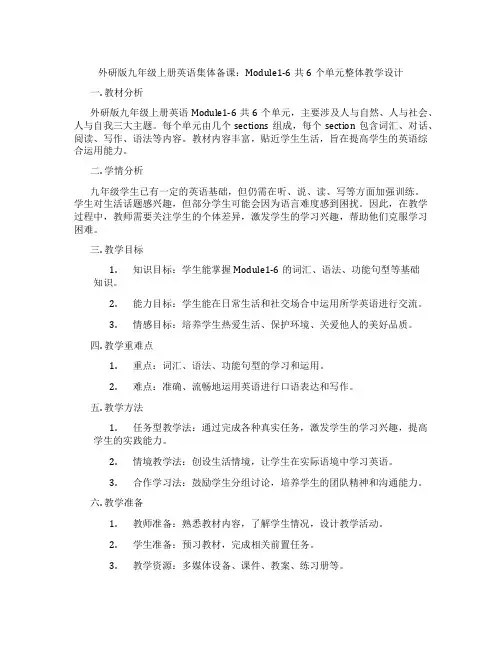
外研版九年级上册英语集体备课:Module1-6共6个单元整体教学设计一. 教材分析外研版九年级上册英语Module1-6共6个单元,主要涉及人与自然、人与社会、人与自我三大主题。
每个单元由几个sections 组成,每个section 包含词汇、对话、阅读、写作、语法等内容。
教材内容丰富,贴近学生生活,旨在提高学生的英语综合运用能力。
二. 学情分析九年级学生已有一定的英语基础,但仍需在听、说、读、写等方面加强训练。
学生对生活话题感兴趣,但部分学生可能会因为语言难度感到困扰。
因此,在教学过程中,教师需要关注学生的个体差异,激发学生的学习兴趣,帮助他们克服学习困难。
三. 教学目标1.知识目标:学生能掌握Module1-6的词汇、语法、功能句型等基础知识。
2.能力目标:学生能在日常生活和社交场合中运用所学英语进行交流。
3.情感目标:培养学生热爱生活、保护环境、关爱他人的美好品质。
四. 教学重难点1.重点:词汇、语法、功能句型的学习和运用。
2.难点:准确、流畅地运用英语进行口语表达和写作。
五. 教学方法1.任务型教学法:通过完成各种真实任务,激发学生的学习兴趣,提高学生的实践能力。
2.情境教学法:创设生活情境,让学生在实际语境中学习英语。
3.合作学习法:鼓励学生分组讨论,培养学生的团队精神和沟通能力。
六. 教学准备1.教师准备:熟悉教材内容,了解学生情况,设计教学活动。
2.学生准备:预习教材,完成相关前置任务。
3.教学资源:多媒体设备、课件、教案、练习册等。
七. 教学过程1.导入(5分钟)利用图片、歌曲、提问等方式引导学生进入学习状态,为新课的学习营造轻松愉快的氛围。
2.呈现(10分钟)展示本节课的主题,引导学生关注关键词汇和句型。
通过图片、实物、动画等直观手段,展示教材内容,帮助学生理解和记忆。
3.操练(15分钟)学生进行口语练习,采用角色扮演、小组讨论等形式,让学生在实际语境中运用所学知识。
教师给予及时反馈,纠正发音和语法错误。
初三英语第二周集体备课教案
初三英语第二周集体备课教案备课范围:Unit1 Section B Self-check -------Reading及Unit2 Section A 1a---GF中心发言人:陈海燕一、Period 4(三课时)1、授课范围:Section B Self-check -------Reading 3c2、授课过程Step 1 Self-CheckSB Page 6, Part 1.1.Ask Ss to fill in the blanks on their own.2.Check the answers.3.Ask Ss to make their own sentences with the words.4.Write a number of students’ answers for each word on the board SB Page 6, Part 2.1.Read the instructions with the students.2.Ask Ss to complete the task by interviewing other students.3.Ask Ss to share their results with the class.SB Page 6, Part 3.1.Read the instructions and sample answer with the students.2.Ask Ss to complete the task.3.Ask Ss to share their short report with the class. Make sure Ss i nclude details.Step 2 While-readingHave you ever been to Singapore?SB Page 7, Section 1. Before Reading1.Ask Ss to answer 6 questions after reading for the for the time. Q1: Where is Singapore?Q2: What languages do people speak in Singapore? Q3: Can you find a lot of Chinese food there?Q4: What is the night zoo named?Q5: What is the best time to see lions, tigers or foxes? Why?Q6: What about the weather in Singapore?SB Page 7, Section 2.Ask Ss to read slowly and thoughtfully. They should be aware of t he words they are reading as they read.SB Page 8, Section 3.1.Ask Ss to scan the reading to find more words for the different categories.2.Ask the class for any unusual words that they have found.SB Page 8, 3c.Tell Ss to first read the false information given in the exercise. Th en ask them to scan the reading to find the correct details to writea true sentence.3.Ss complete the task.4.Check the answers.3、相关练习Exercise designing for Period 4 :单项选择( )1. He to Canada, so you can not see him recently.A. wentB. has beenC. has goneD. have been gone ( )2. —have you been there since you became a teacher —Twice .A. How oftenB. How soonC. How longD. Hoe many times ( )3. London has ever hosted the modern Olympics Paris.A. So doesB. So hasC. Nor doesD. Neither has( )4. —I haven’t been to the space museum. —.A. So do IB. Me tooC. Me neitherD. So have I4、课堂创新点:给学生一定的时间,学生自主学习Self-check, 可以小组讨论,也可下位咨询,也可问老师,最后,学生讲解每句话,并指出其中需要重点掌握的语法点。
人教版新目标九年级英语Unit5单元集体备课教案
第一课时Sect i on A(1a~2d)1.produce(v.)生产;制造2.wide ly(adv.)广泛地;普遍地3.process(v.)加工;处理8.on the s ides o f mount a ins在山边上.What i s the model p lane made of?这个飞机模型是用什么制成的?2.What i s the pa in t ing made f rom?这幅油画是用什么制成的?3.—Is th i s r ing made of s i lver?这枚戒指是由白银制成的吗?—Yes,and i t was made in Tha i land.是的。
并且它是在泰国制造的。
4.Where i s t ea p roduced in China?在中国,哪些地方产茶?Teacher: P lease t ake out your th ings on your desk.We use them every day,do you rea l ly know them?Ques t ions:教学过程Step 2完成教材1a-1c的任务5.小结训练。
要求学生在规定的时间内完成一个小练习。
并请若干学生给出自己的答案。
有错误的话及时纠正。
(2分钟)用括号内所给动词的正确形式填空。
1)The apples a re sen t(send)to the fac tory f or p rocess ing.2)We are a l l r eady bu t Tom hasn’t packed (pack) h i s c lo thes ye t.3)The windows of the room are c leaned(c lean)every day.4)The bes t co t ton i s p r oduced(p roduce)in Xing J iang in China.5)The song isn’t liked (no t l ike) by mos t o f us.环节说明:通过学习1a,使学生对被动结构有所了解;通过1b,锻炼学生的听力及抓取关键信息的能力;通过1c的训练锻炼学生的口头表达能力,同时巩固对一般现在时被动结构的认识。
人教版新目标九年级英语Unit9单元集体备课教案
3.The English teacher asked us to learn thisdialogue(对话) by heart.
4.My father prefers thedocumentaries (纪录片) to the action movies.
3)我的朋友更喜欢能够随之跳舞的音乐。
My friendprefersmusic that she can danceto.
4)这位美国老太太喜爱能够随着哼唱的音乐。
The American old lady loves musicthatshe can singalongwith.
Step 3完成教材2a-2d的任务
Xu Fei:I prefer groups that playquite and gentlesongs.I like musicians who writestheir ownsongs.
Carmen:I love music that’s reallyloud and energetic.I like musicians who playdifferent kinds of music.
【操作案例】
1.要求学生翻开课本P66。要求学生迅速捕捉图片和文字信息,然后为他们播放第一遍录音,完成2a,2b的听力任务。(2分钟)
2.要求学生听第二遍录音,并逐句进行跟读,教师应作必要的听力和朗读指导。(2分钟)
3.听力内容巩固训练。要求学生根据所听到的内容完成下列各句。完成后要求若干学生给出自己的答案。以巩固对听力内容的了解。(4分钟)
初三英语集体备课教案
初三英语集体备课教案【篇一:九年级英语集体备课教案】九年级英语集体备课教案【篇二:九年级英语集体备课教案】九年级英语集体备课教案主备人:孙海燕讨论:孙海燕黄子恺黄江萍课题: unit 3 teenagers should be allowed to choose their own clothes第一课时section a 1a-2c学习目标:1、掌握should be allowed to 的用法2、重点词汇license , silly , earring , instead of,pierce,serious,choose(chose,chosen)中考考点:should be allowed to 的用法学习重点:练习听力及对话学习难点:重点词汇用法及正确运用被动语态教学流程:一:课前检测二:自主学习16岁的青少年____________________被允许和朋友一起外出___________不够认真______________ 年龄不够大三:探究展示1:teenagers should be allowed to choose their own clothes.(1)should be allowed 为含有情态动词的被动语态,英语动词有两种语态,既主动语态和被动语态,主动语态表示主语是动作的执行者,被动语态表示主语是动作的承受者. 被动语态的构成:主语+be+及物动词的过去分词 be有人称和时态的变化.eg: 我们学校每年都栽树. trees in our school every year. . 被动语态的用法:(1)不知道动作的执行者是谁。
这栋楼是5年前建的。
the building was built 5 years ago.(2)没有必要指出谁是动作的执行者。
校园天天都被打扫。
the school yard every day.(3)需要强调动作的承受者。
eg: 英语被广泛应用。
- 1、下载文档前请自行甄别文档内容的完整性,平台不提供额外的编辑、内容补充、找答案等附加服务。
- 2、"仅部分预览"的文档,不可在线预览部分如存在完整性等问题,可反馈申请退款(可完整预览的文档不适用该条件!)。
- 3、如文档侵犯您的权益,请联系客服反馈,我们会尽快为您处理(人工客服工作时间:9:00-18:30)。
初三英语集体备课教案备课内容:9A Unit 2 Colour一、备课时间:2006. 9. 1二、备课人员:备课教师:Unit 2 Color第一课时Welcome to the unitObjectivesTo recognize the names of different colorsTo recognize the colors of the rainbow and the order of the colorsTeaching procedures1.Ask students to raise their hands if they have ever seen a rainbow. Ask students to tell you when a rainbow occurs.2. Explain to students that the colors of a rainbow always appear in order shown in the picture on page 21. Ask them to write the colors in the blanks in Part A. This is a simple exercise and the students can work on their own.3. For Part B, ask two students to play the roles of Amy and Amy’s cousin. Ask them to read the conversation aloud.4. Ask students to list the colors of the names of the colors in the correct order.Language points.Comic Strips1. I’d rather wear blue than pink. 我宁愿穿蓝色也不愿穿粉红色。
would rather… than… 表示“宁愿…而不愿…”,“更愿意…”;rather后跟动词原形。
e.g. I’d rather play tennis than swim.He’d rather stay at home than go out on such a rainy day.2. There’s nothing wrong with pink, you know. 你是知道的,粉红色本身没有错。
nothing 是不定代词,它通常放在所修饰的形容词之前。
类似的不定代词还有something/somebody; anything/anybody; nobody/nothing/no one 等。
There is nothing/ something wrong with sb./ sth. 表示某人/某个东西没出/出了毛病。
e.g. There is something wrong with my watch It doesn’t work.以上句子也可以用以下方式表示:Nothing is wrong with pink.3. But blue looks good on you. 但蓝色穿在你身上看上去很好看。
look good 看上去好看的,on you 表示“穿在你身上”的意思。
4. Pink is a girl’s colour. 粉红色是女孩子穿的颜色。
★colour/color用作名词,意为“色彩”“颜色”。
如:①This kind of insect can change colour. 这种昆虫会变色。
②They bought a new colour television last month. 上个月他们买了一台新彩电。
③What colour is your new car? 你的新车是什么颜色?④This dress fits well but I don’t like the colour. 这衣服很合身,但我不喜欢这颜色★colour用作动词,意为“着色”“涂颜色于……”。
如:①He coloured the wall white. 他把墙涂成白色。
②His younger sister is colouring a picture. 他的妹妹正在给一幅画涂上颜色。
③Why don’t you colour your dog brown? 你为何不把狗涂成褐色呢?5. I’d rather wear blue than pink. 我宁愿空蓝色的也不愿穿粉红色的。
★rather用作表示程度的副词,意为“相当”“太”,与very, quite, too同义,用来修饰形容词或副词。
如:①This book is rather bad. 这本书不太好。
②The girl is rather ugly. 这女孩很难看。
③The book is rather easy. 这本书相当容易。
④She was very thin, but rather tall. 她很瘦,但相当高。
⑤He is driving rather fast. 他开车开得相当快。
★rather和quite可用来修饰名词,一般放在冠词前面,但如果名词前有形容词,也可放在a / an 冠词的后面。
如:①It’s rather / quite a pity. 这太可惜了。
②He seemed to take rather / quite a fancy to me. 在我看来,他似乎相当漂亮。
③It’s a rather / quite good idea. (=It’s rather / quite a good idea.) 这可真是个好主意。
④That’s a rather / quite good film. (=That’s rather / quite a good film.)那倒是一部很好的电影。
⑤It was rather / quite a cold day. (=It was a rather / quite cold day.)那是相当寒冷的日子。
★would rather意为“宁愿”“宁可”,后接动词原形,否定式时,not要放在would rather之后。
如:①I would rather go there tomorrow. 我宁愿明天去那儿。
②She would rather stay at home. 他宁愿呆在家里。
③Which would you rather have, tea or coffee? 你愿意吃哪个,茶还是咖啡?④He would rather not go to the party. 他宁可不去参加聚会。
⑤I’d rather not tell you about it. 我不愿告诉你此事。
★would rather…than…美国人也用had rather…(than),通常省略成’d rather,意为“宁愿……而不愿……”。
如:①I’d rather stay at home than go to the park today. 我今天宁愿呆在家而不去公园。
②She would rather walk there than take a bus. 她宁愿步行去那儿,也不愿意坐汽车去。
③She’d rather die than lose than children. 她宁愿死,也不愿意失去孩子。
④She would rather have the small one than the large one. 我宁愿要小的,而不要大的。
⑤We would rather have the meeting in the classroom than in the hall.我们宁愿在教室开会,也不愿意在礼堂开会。
(有心中舒服的感觉)Unit 2 Color第二课时Reading 1ObjectivesTo understand what colors representTo recognize and understand vocabulary about emotionsPart A Teaching procedures1. Read the passage aloud. Ask students to listen to you carefully and follow the text on the page.2. Ask one student at a time to read a paragraph. After each paragraph, ask students to say which parts of the text they do not understand.3. Ask more able students what they think about the article. Do they agree with what it says or which part of it do they like most? Encourage more able students to give reasons for their answers.4. Ask students to tell the class any interesting facts they know about the colors.Part B. Teaching procedures1. Ask students to read Part A on page 22 and 23 again and use the information to complete Part B1 on page 24.2. Ask students to work in pairs to complete Part B2. Ask students to raise their hands when they have finished. The first pair to finish the exercise correctly is the winner.3. After students have finished, give the correct answer to each question.Language points1. Do you know anything interesting about colours? 你知道关于颜色的一些有趣的事情吗?anything interesting 一些有趣的事情, anything 是不定代词,形容词interesting要放在它的后面。
